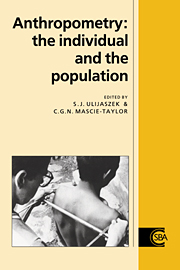Book contents
- Frontmatter
- Contents
- List of contributors
- Preface
- Acknowledgements
- 1 The place of anthropometry in human biology
- 2 Asymmetry and growth
- 3 Intra- and inter-observer error in anthropometric measurement
- 4 Statistical issues in anthropometry
- 5 Statistical constructs of human growth: new growth charts for old
- 6 Growth monitoring and growth cyclicities in developed countries
- 7 Growth monitoring, screening and surveillance in developing countries
- 8 Variability in adult body size: uses in defining the limits of human survival
- 9 Anthropometry and body composition
- 10 Anthropometry and physical performance
- 11 Anthropometry, strength and motor fitness
- 12 Anthropometry in the US armed forces
- Index
7 - Growth monitoring, screening and surveillance in developing countries
Published online by Cambridge University Press: 19 November 2009
- Frontmatter
- Contents
- List of contributors
- Preface
- Acknowledgements
- 1 The place of anthropometry in human biology
- 2 Asymmetry and growth
- 3 Intra- and inter-observer error in anthropometric measurement
- 4 Statistical issues in anthropometry
- 5 Statistical constructs of human growth: new growth charts for old
- 6 Growth monitoring and growth cyclicities in developed countries
- 7 Growth monitoring, screening and surveillance in developing countries
- 8 Variability in adult body size: uses in defining the limits of human survival
- 9 Anthropometry and body composition
- 10 Anthropometry and physical performance
- 11 Anthropometry, strength and motor fitness
- 12 Anthropometry in the US armed forces
- Index
Summary
Hundreds of thousands of children have their weight measured daily. Somewhat fewer have their length or height measured and others receive measurement of their mid-upper arm circumference (MUAC). Such measurements are often considered to be core skills of nutritionists or nutritionally orientated health workers. Why? What is the use of collecting such data in so many individuals and so frequently? Does it really assist in the assessment of an individual, or guide those who are trying to improve that individual's nutrition? Does anthropometry lead to action, or, at the very least, to the development of policies aimed at improving the nutrition of entire communities or particularly vulnerable groups within those communities? This paper examines current practices and assesses the different purposes of anthropometric measurements in a range of situations.
There is now a wide range of equipment for measuring weight, to varying degrees of accuracy. In less developed countries (LDC) the most commonly used scale reads up to 25 kg in intervals of 100 g; such a scale, consisting of an accurate torsion spring with a dial display, costs around £30–40. More sensitive measurements, to 10 g of accuracy, may be obtained using machines with battery-powered digital displays, costing around £160. Even more accurate balances, involving integration with multiple readings taken every second over a 10 s time period cost over £1000. There are variants on these scales. The recent development of a torsion coil spring enables the observer to mark a chart which is placed alongside the scale in such a way that the weight is recorded at the appropriate age band on a Road to Health chart (TALC, UK).
- Type
- Chapter
- Information
- AnthropometryThe Individual and the Population, pp. 108 - 116Publisher: Cambridge University PressPrint publication year: 1994
- 4
- Cited by



